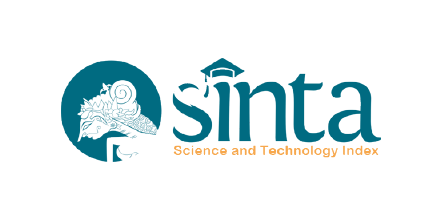"Slowly But Sure"
A Language Deficit of a Child with Down Syndrome
DOI:
https://doi.org/10.21776/ub.ijds.2021.008.02.09Keywords:
Language Deficit, Down Syndrome, Language DevelopmentAbstract
This is a case study research in this paper reports on findings from the case study (syntactic and morphological) in an individual diagnosed with a genetic disorder, Down Syndrome (DS), that affect language development without getting the help of any official therapists. We perform pragmatic and phonological analyses alongside morphology and syntactic analyses on data collected from studying documents, observation, and interview results. The qualitative descriptive linguistic method is used in this study to provide a detailed description. The result shows some deficits performed by the DS caused by articulatory limitation, difficulty to follow some words in long statements, and difficulty to respond to the topic that he has not known before.
References
Abbeduto, L., Murphy, M. M., Richmond, E., Amman, A., Beth, P., Weissman, M. D., et al. (2006). Collaboration in referential communication: Comparison of youth with Down syndrome or fragile X syndrome. American Journal on Mental Retardation, 111, 170.
Andrade, R. V., Cecilia, S., & Limongi, O. (2014). The use of augmentative and alternative communication in morphosyntax intervention in adolescents with Down Syndrome. Morphosyntax in Down Syndrome, 16(3), 863-873.
Beeghly, M., Weiss-Perry, B., & Cicchetti, D. (1990). Beyond sensorimotor functioning: Early communicative and play development of children with Down syndrome. In Children with Down syndrome: A developmental perspective (pp. 329-368). New York: Cambridge University Press.
Caselli, M. C., Vicari, S., Longobardi, E., Lami, L., Pizzoli, C., & Stella, G. (1998). Gestures and Words in Early Development of Children With Down Syndrome. Journal of Speech, Language, and Hearing Research, 41, 1125-1135. https://doi.org/https://doi.org/10.1044/jslhr.4105.1125
Chapman, R. S. (1998). Language development in children and adolescents with Down syndrome. MENTAL RETARDATION AND DEVELOPMENTAL DISABILITIES RESEARCH REVIEWS, 3(4), 307-312. https://doi.org/https://doi.org/10.1002/(SICI)1098-2779(1997)3:4<307::AID-MRDD5>3.0.CO;2-K
Chapman, R. S., Hesketh, L. J., & Kistler, D. J. (2002). Predicting longitudinal change in language production and comprehension in individuals with Down syndrome: hierarchical linear modeling. Journal of Speech, Language, and Hearing Research, 45(5), 902-915. https://doi.org/10.1044/1092-4388(2002/073).
COGGINS, TRUMAN E. Ph.D. CARPENTER, ROBERT L. OWINGS, N. O. (1983). No TitleExamining Early Intentional Communication in Down's Syndrome and Nonretarded Children. International Journal of Language & Communication Disorders, 18(2), 98-106. https://doi.org/https://doi.org/10.3109/13682828309019827
Dodd, B., & Thompson, L. (2001). Speech disorder in children with Down's syndrome. Journal of Intellectual Disabilities Research, 45(4), 308-316.
Fletcher, P. & Miller, J.F. (2005). Developmental theory and language disorder, Philadelphia: John Benjamin Publishing Company
Fromkin, V., Rodman, R., & Hyams, N. (2013). An Introduction to Language (10th ed.).
Hesketh, L. J., & Chapman, R. S. (1998). Verb use by individuals with Down syndrome. American Journal on Mental Retardation, 103(3), 288-304. https://doi.org/10.1352/0895-8017(1998)103<0288:VUBIWD>2.0.CO;2.
Kaderavek, J. N. (2011). Language disorders in children. Upper Saddle River, New Jersey: Pearson Education.
Kumin, L. (1994). Intelligibility of Speech in Children with down Syndrome in Natural Settings: Parents' Perspective. Perceptual and Motor Skills, 78, 307-313. https://doi.org/https://doi.org/10.2466%2Fpms.1994.78.1.307
Lahey, M., & Bloom, L. (1978). Language Disorders and Language Development. New York Macmillan; London: Collier Macmillan.
Laws, G., & Bishop, D. V. M. (2003). A Comparison of Language Abilities in Adolescents With Down Syndrome and Children With Specific Language Impairment. Journal of Speech, Language, and Hearing Research, 46, 1324-1339. https://doi.org/https://doi.org/10.1044/1092-4388(2003/103)
Manipuspika, Y. S., & Sudarwati, E. (2019). Phonological Development of Children With Speech Delay. 5(1), 12-22.
Martin, G. E. P., Klusek, J. M., Estigarribia, B. P., & Roberts, J. E. P. (2009). Language Characteristics of Individuals with Down Syndrome. Topics in Language Disorders, 29(2), 112-132. https://doi.org/https://doi.org/10.1097/tld.0b013e3181a71fe1.
McNeilly, L. (2011). American Speech-Language-Hearing Association (ASHA). In Encyclopedia of Clinical Neuropsychology (pp. 138-139). Springer New York. https://doi.org/10.1007/978-0-387-79948-3_2148.
Moleong, L. J. (2003). Metodologi Penelitian Kualitatif. Bandung:Remaja Rosdakarya.
Owens, R. E. (2008). Language development: An introduction. New York: Pearson Education.
Paul, R & Norbury, C. F. (2012). Language disorders from infancy through adolescence, US: Elsevier Mosby
Perovic, A. (2006). Syntactic deficit in Down syndrome: More evidence for the modular organisation of language. 116, 1616-1630. https://doi.org/10.1016/j.lingua.2005.05.011
Roberts, J. E., Long, S. H., Malkin, C., Barnes, E., Skinner, M., & Hennon, E. A. (2005). A comparison of phonological skills of boys with fragile X syndrome and Down syndrome. Journal of Speech, Language, and Hearing Research, 48, 980-995.
Roberts, J. E., Price, J., & Malkin, C. (2007). LANGUAGE AND COMMUNICATION DEVELOPMENT IN DOWN SYNDROME. MENTAL RETARDATION AND DEVELOPMENTAL DISABILITIES RESEARCH REVIEWS, 35(December 2006), 26-35. https://doi.org/10.1002/mrdd.
Roberts, J., Long, S. H., Malkin, C., Barnes, E., Skinner, M., Hennon, E. A., & Anderson, K. (2005). A Comparison of Phonological Skills of Boys With Fragile X Syndrome and Down Syndrome. Journal of Speech, Language, and Hearing Research, 48(5), 980-995. https://doi.org/10.1044/1092-4388(2005/067).
Selikowitz, M. (2008). Down syndrome; the Facts, 3rd edition. China: Oxford University Press.
Tannock, R. (1988). Mothers' directiveness in their interactions with their children with and without Down syndrome. American Journal on Mental Retardation, 93(2), 154-165.
Weinzapfel, R. (2014). Syntax Development in Adolescents and Adults with Down Syndrome. http://opensiuc.lib.siu.edu/gs_rp%5Cnhttp://opensiuc.lib.siu.edu/gs_rp/495
Downloads
Published
How to Cite
Issue
Section
License
Copyright (c) 2021 Aisyah Tiara Rahmah, Emy Sudarwati

This work is licensed under a Creative Commons Attribution-NonCommercial 4.0 International License.















